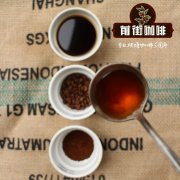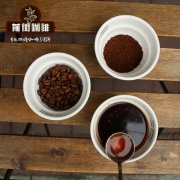How many kinds of coffee fruit treatments are there? Sun, half-water washing, half-sun washing, whole water washing, honey treatment

Professional coffee knowledge exchange more coffee bean information please follow the coffee workshop (Wechat official account cafe_style)
How many kinds of coffee fruit treatments are there? What is the difference between sunbathing, half-washing, half-sunbathing, full-washing and honey treatment? What's the difference between different treatments?
It refers to the process of turning ripe red fruits into dried raw beans. Each treatment method has its own advantages and disadvantages, and is affected by the natural environment and demand of the producing area. Therefore, each producing area has its own suitable treatment method, which can be roughly divided into three treatment methods.
Different treatments can create different flavors of coffee, which occupies a very important part of coffee flavor.
☀️ solarization method
Also known as natural drying and non-washing treatment, the collected coffee fruit is dried in the sun and shelled, which absorbs the taste of the peel and pulp in the process of exposure for a long time, while making the sweetness and alcohol thickness of the coffee fuller, easy to produce unique aroma.
Directly put the coffee fruit in the sun for exposure, when the moisture content of the coffee bean is lower than a certain degree, and then use the machine to remove the exocarp to the endocarp at once, the advantage is rich in flavor, the disadvantage is that it will produce more defective beans and need more space.
Full washing method
After removing the pericarp and pulp, soak in water in the fermentation tank to ferment, remove the residual pectin mucosa on the inner pericarp, and then rinse with water, which has the rich acidity of one of the fine coffee conditions.
First remove the exocarp and pulp, leaving the pectin layer, then put the coffee beans into the fermentation tank, make the pectin layer disappear and then dry, and finally remove the exocarp, the advantage is that the yield of raw beans is higher, and the disadvantage is that the washed beans are sour, and the aroma is not as good as the sun method, and the sweetness is not as high as the sun method.
️semi-washing method
Semi-washing is to choose not to put the raw beans with pectin layer into the fermentation tank, but to remove the pectin layer of raw beans by machine, then dry and remove the pericarp, which is not as sweet as sun beans but not washed with water.
Also known as half-washing, half-sun method, this is a compromise between drying and washing, after removing the peel and pulp, do not use a fermentation tank, but let it retain the pectin mucosa to be dried in the sun, and then remove the dried gelatin. the flavor produced is between the sun drying method and the water washing method.
Coffee cherry is composed of exocarp, pulp, pectin layer, endocarp, silver peel and coffee germ from outside to inside, so coffee beans will be treated by various methods before they are turned into raw beans for export.
️half-sun method
Half-sun drying is to directly expose the raw beans with pectin layer to the sun, and remove the peel after drying until the moisture content is lower than a certain degree, while the treatment according to the residual degree of the pectin layer is derived into another treatment-honey treatment.
Honey treatment method
According to the degree of residual pectin layer, it can be divided into black honey, red honey, yellow honey and white honey treatment, and the advantage of honey treatment is that it can be deacidified, so Costa Rica prefers honey treatment to sour beans to make it sweeter.
Important Notice :
前街咖啡 FrontStreet Coffee has moved to new addredd:
FrontStreet Coffee Address: 315,Donghua East Road,GuangZhou
Tel:020 38364473
- Prev

Coffee fruit treatment method solarization method, washing method or half sun method which is better? What's the difference? Yes
Professional coffee knowledge exchange more information about coffee beans Please follow the coffee workshop (Wechat official account cafe_style) Coffee fruit treatment method which is better, washing or half-sun? What's the difference? What are the flavor and taste characteristics? The oldest treatment of solarization (Natural) is widely used in sunny, water-poor and less affluent areas.
- Next

The story of the flavor characteristics of Indonesian wet planing coffee beans
Professional coffee knowledge exchange more coffee bean information please follow the coffee workshop (Wechat official account cafe_style) which beans in Indonesia are wet shaved? What flavor does wet planing highlight? What is wet planing? Wet planing (Wet-Hulling), that is, when the raw beans are in the middle of the sun and the moisture content is as high as 30% 50%, the seed shells are removed before continuing.
Related
- Detailed explanation of Jadeite planting Land in Panamanian Jadeite Manor introduction to the grading system of Jadeite competitive bidding, Red bid, Green bid and Rose Summer
- Story of Coffee planting in Brenka region of Costa Rica Stonehenge Manor anaerobic heavy honey treatment of flavor mouth
- What's on the barrel of Blue Mountain Coffee beans?
- Can American coffee also pull flowers? How to use hot American style to pull out a good-looking pattern?
- Can you make a cold extract with coffee beans? What is the right proportion for cold-extracted coffee formula?
- Indonesian PWN Gold Mandrine Coffee Origin Features Flavor How to Chong? Mandolin coffee is American.
- A brief introduction to the flavor characteristics of Brazilian yellow bourbon coffee beans
- What is the effect of different water quality on the flavor of cold-extracted coffee? What kind of water is best for brewing coffee?
- Why do you think of Rose Summer whenever you mention Panamanian coffee?
- Introduction to the characteristics of authentic blue mountain coffee bean producing areas? What is the CIB Coffee Authority in Jamaica?

